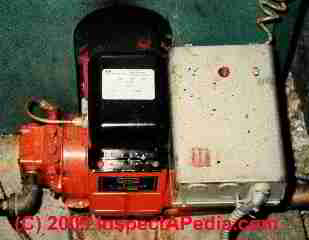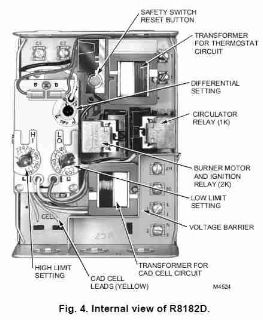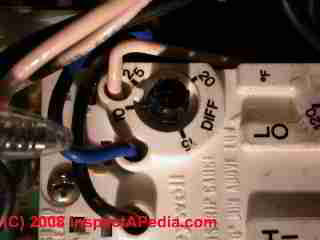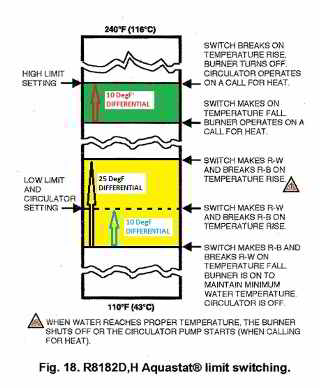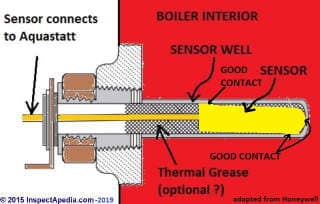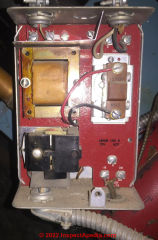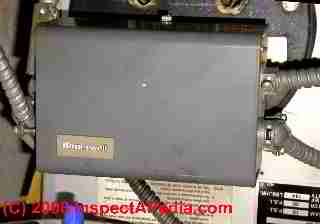 Heating System Boiler Aquastats
Heating System Boiler Aquastats
Buy, replace, install, set-up, & wire R8182D & all other heating system aquastat controls
- POST a QUESTION or COMMENT about Aquastats controls used on Heating Boilers
Guide to aquastat controls on heating equipment:
Beginning by using the Honeywell R8182D series aquastats, this article series explains how aquastats work and what the different aquastat controls are, what they do, and how they are set. We define the HI LO and DIFF controls on heating boiler aquastats and explains what they do and how they work. We explain the location and use of the heating boiler reset button found on aquastats.
We discuss relationship among HI, LO, DIFF, and heating burner cut-in, cut-out, and circulator lockout that are provided on the combination control. We explain how the Aquastat controls hot water production via a tankless coil on the heating boiler.
We explain how to disable the LO control when a tankless coil is not in use on a boiler. After explaining the operation of an aquastat's Hi, Lo, and Diff controls we review the newer universal replacement aquastat from Honeywell, the L7224U Universal Aquastat, followed by a discussion of the simpler single-limit control switches.
InspectAPedia tolerates no conflicts of interest. We have no relationship with advertisers, products, or services discussed at this website.
Aquastat Guide to the Reset Button & HI LO & DIFF Temperature Settings on Heating Boiler Controls - Aquastats & Primary Controllers
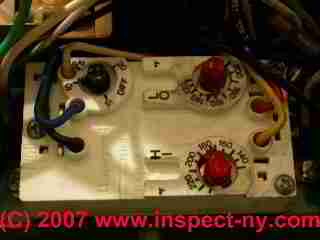 The photo at page top shows a Honeywell R8182D combination heating control, also called an "aquastat".
The photo at page top shows a Honeywell R8182D combination heating control, also called an "aquastat".
But with the cover on you can't see much. Here at left is part of an inside view of a typical aquastat showing the three controls that need to be correctly set.
[Click to enlarge any image]
If you just want to set the HI LO and DIFF controls and don't care how they work or what they do, see our separate article
On AQUASTAT HI LO DIFF SETTINGS
This article series answers most questions about Heating System Boiler Controls on central heating systems to aid in troubleshooting, inspection, diagnosis, and repairs.
Here we explain how to set and adjust the heating system controls to preserve this cold marriage.
Also see TANKLESS COIL HOT WATER HEATER TEMPERATURE CONTROL
How to Find and Use the Reset Button on the Aquastat Combination Control on a Boiler
Summary of the Functions of a Typical Combination Protectorelay™ Primary Control and Aquastat® Controller
Our photo shows an older aquastat type primary controller on an oil fired heating boiler. You can see the gray box covering the control in the right in our photo.
Depending on wiring hookup choices, this control operates the heating system oil burner, circulator, and zone circulators. It can also be configured (factory default) to keep the heating boiler hot to provide domestic hot water through a tankless coil even when the building room thermostats are not calling for heat.
The aquastat controller often also includes connections to a flame sensing device, typically a cad-cell
(CAD CELL RELAY SWITCH) or on older heating systems a stack relay
(STACK RELAY SWITCH) to shut down the boiler if the burner is not operating properly.
There is a "reset" button to re-start the heating system if it has shut down for safety. We discuss all of these controls in detail below.
See RESET SWITCH on PRIMARY CONTROL
The coiled "wire" leaving the upper right corner of this control is routed to a thermal sensor mounted in a well inserted into the water of the heating boiler.
Unlike the aquastat shown at the top of this page, poking through the upper-center of the cover of this heating system control you'll see a red "reset button" in the center of the upper portion of the gray control box.
If this heating boiler has turned itself off on SAFETY OFF you'll see that the button will have popped up higher out of the control cover.
If the red "reset" button on the this safety control is sticking up and the oil burner has shut down, the homeowner is permitted to try ONCE ONLY to "reset" the system by pressing the red reset button. Please be sure to read our more detailed instructions for using the reset button on heating equipment at our article:
Watch out: sometimes the red plastic button on older heating equipment primary controls can break off.
At RESET SWITCH, HEATER REPAIR we show how to reset the equipment safely if this happens to you.
Where are the reset buttons? If you are looking for the a reset button that may have tripped off heating equipment see:
- AQUASTAT RESET BUTTON (reset button found on aquastats used on heating equipment such as boilers & water heaters.
- CAD CELL RELAY SWITCH (hot water boilers and some water heaters)
- ELECTRIC PANEL INSPECTION where to find circuit breakers controlling heating equipment
- FIREMATIC FUSIBLE ELECTRICAL SWITCH interrupts electrical power in event of fire near heating equipment
- STACK RELAY SWITCH On older oil fired boilers and furnaces,
- FLUE GAS SPILL SWITCH TRIPPING & RESET (gas fired equipment),
- LOW WATER CUTOFF CONTROLS On steam heating systems.
- ELECTRIC MOTOR OVERLOAD RESET SWITCH the thermal overload switch and reset button that is found on many electric motors including those operating air conditioning fans, heating system oil burners, and furnace blowers and motors.
Question: We have to hit the reset button on our furnace for it to run.
(Nov 23, 2015) Jackie said:
We have to hit the reset button on our furnace for it to run.
It runs for 4-5 heating/hot water cycles,then reset button again.
We took the cover off the Aquastat(L8124A) and saw a semi exposed wire and the circuit board looks like it been arced. Not sure if arcing mark is from close proximity to exposed wire or damage to board. Should I replace connector(to correct exposed wire) or aquastat or control box?
(6 March 2016) Kev said:
My overheat button knocks off boiler its a honeywall.is there a suggestion what might cause this
Reply: do NOT keep pressing the heater or water heater reset button
Jackie:
Watch out: repeated use of the re-set button risks a dangerous puffback explosion. That's because the burner that is shutting off on "safety" may leave un-burned fuel in the combustion chamber; it can accumulate until we have an ugly experience.
If you see arcing burns on the circuit board I suspect the problem may be more than the wire - perhaps overheating. I would ask for an inspection by your heating service tech to decide:
1. what's causing the system to go off on re-set
2. what caused the arcing you found
3. based on those steps, repair or replace what's needed.
I understand the appeal of just plugging in a new part - certainly I do that myself. But just swapping in a new control or circuit board without having an idea of what was happening risks having to repeat the repair.
See OIL BURNER SOOT & PUFFBACKS
Kev:
If you are referring to the reset button on an oil fired heating system most likely the problem is with the oil burner: an inadequate or faltering flame. DO NOT keep pressing the reset button as you could cause a dangerous puffback explosion. I'd call for service.
Guide to Function & Settings on Combination or Multi Function Primary Controls (Aquastats) for Heating Boilers
Here we explain how to find and use the Aquastat reset button and how to find the HI LO and DIFF controls on aquastats. We explain how the HI LO and DIFF controls function to turn the burner on and off for both heating and for systems where a tankless coil is in use, also for making domestic hot water.
This article series answers most questions about Heating System Boiler Controls on central heating systems to aid in troubleshooting, inspection, diagnosis, and repairs.
At night we turn down the thermostat to 55°F to try to save on our heating cost.
But our hot water is made with a tankless coil. This morning my wife got out of bed and stepped into the shower for a nice hot wake up. She turned on the water, pretty hot, and stepped in to its comforting stream.
I walked over to the thermostat and turned it up to 90 - thinking (in error) that the thermostat is like an accelerator, and the higher I set it the faster the house would reach a comfortable 72 degrees (wrong). I figured my wife would be able to step out of the shower into a nice warm house.
Moments later I heard screaming from the shower as my wife got hit with freezing cold water. What happened? -- anonymous.
Basic Boiler Operation & Control Sequence using an Aquastat
On a call for heat from the thermostat, the zone circulator starts when water temperature is above Low Limit setting (if applicable - that is, if this feature is enabled - the default).
The heating boiler temperature is checked. The burner starts when the water temperature is below High Limit setting.
When the boiler temperature reaches or exceeds the High Limit, the burner is turned off. The burner restarts when the
water temperature drops back below the High Limit
setting minus the differential.
As long as the circulator is continuing to call for heat and provided the control has not "locked out" the circulator (as we discussed above) the zone circulator will continue to circulate hot water through the heating zone.
When the thermostat is satisfied - that is room temperature has reached the thermostat setting, the circulator and burner are turned off. Stated with a bit of simplification, on most common boiler control set-ups in the U.S. the thermostat turns the circulator on or off, and the temperature of water in the boiler turns the burner on and off.
(Heating systems in Canada operate differently: there most techs set up the circulator to run continuously if the boiler is "on" and a call for more heat at the thermostat turns the boiler's burner on until the thermostat is satisfied.)
Combination control or primary control on heating boilers: this control, such as a Honeywell R8182D combine High Limit and "Low Limit" boiler controls
(The dial marked "low limit" on a combination control may or may not be in use depending on presence of a tankless coil).
This primary control or aquastat is the most common type on modern heating boilers in North America. It
controls the oil burner operation, turning the burner on or off as the boiler low limit or high limit temperatures are reached respectively.
This control may
switch on and off a single circulator pump, and if a tankless coil is installed on the boiler, it may also turn the oil burner on and off as needed to maintain
temperature in the boiler to provide domestic hot water as well.
This control can also be used to control the burner and the first circulator of a multi-circulator zoned hot water heating system. The other circulators are controlled by individual circulator relays and thermostats.
What are the Three HI LO DIFF Controls & Dials We See Inside the Cover of the Honeywell R8182D Aquastat
Heating Control Operation Sequence: With some simplifications, the room thermostat calls for heat. The circulators start running, hot water leaves the boiler and heads for radiators or baseboards, cooler water returns from the building into the boiler. Boiler temperature drops to the cut-on or cut-in temperature.
The burner turns on and re-heats the heating water inside the boiler until boiler temperature reaches the cut-off or cut-out temperature. The circulators keep running, and the boiler burner may cycle on and off in this manner, until the room thermostat is satisfied. Then the thermostat turns off the circulators and the burner, if running, will shut off when the boiler reaches the HI limit.
In Canada boilers operate a bit differently: the circulator pump may be set to run continuously, and the thermostat just turns the burner on and off. This gives more even heat and helps avoid a frozen heating zone pipe in very cold climates. Our aquastat function explanation below is bases on the "American" model or as the Canadians say, "the Yanks".
How the Aquastat HI Limit Settings and Functions Work to Control Building Heat: R8182D & Other Aquastats
[Click to enlarge any image]
Shown above, the Honeywell R8182D
Also see AQUASTAT R8182D,H Combination Protectorelay MANUAL [PDF] to download the manual for this control.
HI Limit: Combination Control High Limit:
The HI cut off temperature for the burner: on a typical aquastat or combination control, the "Hi Limit" setting specifies the cut-off temperature for the heating boiler's burner on a call for heat.
That means that when the burner is running it will heat water inside the heating boiler until that water temperature reaches the HI or cut-off point. Then the burner is turned off.
The HI cut-on temperature for the burner is hard wired in this HI Limit control at 10 °F below the "Hi Limit" setting.
Example: Hi set to 200. Thermostat calls for heat. Circulators turn on. Hot water leaves the boiler, cooler water returns to the boiler, boiler temperature drops to 190, burner turns on and stays on until boiler temperature reaches 200 F.
The internal view of the Honeywell R8182D (left) can be found along with additional details about this control in the Honeywell R8182D,H Combination Protectorelay™ Primary Control and Aquastat® Controller Installation Instructions (link to copy below atReferences or Citations ).
Following wiring details in the instruction manual, the R8182D,H can replace other aquastat controls such as the Tradeline R8182B, R8182E, R8182F, R8182H, R8182J, or White Rogers 6C92.
A newer combination control from Honeywell, the
HONEYWEELL L7224U Oil Electronic Aquastat Controller [Web article] can replace more than 40 older hydronic controls.
How the Aquastat LO Limit Settings and Functions Work to Provide Domestic Hot Water & Circulator Lockout, R8182D & Others
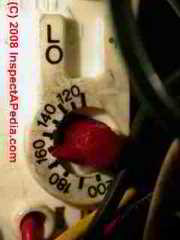
During the summer, because the thermostat never calls for heat, the HI control will never turn on the boiler. The HI limit operates a relay that is turned on by the thermostat and turned off by the boiler reaching the HI or cutoff point.
Out of heating season, your thermostat stops asking for heat, so the HI goes to sleep.
Out of the heating season, the LO gets to work, as we describe here.
What the LO limit actually does: The LO limit is a setting which is intended to maintain heat inside the boiler in order to assure that the boiler can produce hot water when a tankless coil is installed and when the room thermostat's calls for heat are not already keeping the boiler nice and hot.
During warm months when the boiler is not being called-on to heat the building itself, the "Low Limit" keeps heat in the boiler for the tankless coil.
So the "Low Limit" is actually a "low range" operating upper limit On boiler temperature that applies out of the heating season or when the thermostat is not calling for heat.
On typical aquastat heating control the LO or "Low Limit" is NOT the "cut on" point for heat (we explained the heat cut-on just above).
It is helpful in understanding the LO limit to call this the "circulator" controller. Provided that DIFF is set to 10 (its smallest value), then
when boiler temperature falls 10 °F below the LO setting, the burner turns on and the circulator is forced to turn off - we call this "circulator lockout" - we are re-heating water in the boiler and we are preventing boiler water from being sent out to the baseboards or radiators - giving priority to heating the tankless coil.
when boiler temperature rises back up to the LO setting, the burner turns off and the circulator is allowed to turn on - we are unlocking the circulator and allowing the building to be heated again - and taking priority away from giving heat to the tankless coil.
We say the circulator is allowed to turn on because if the room thermostat is not calling for heat, the circulator may have permission to turn on, but the thermostat is leaving the circulator(s) turned off (in the U.S., not on many Canadian heating systems).
And note that we say that the burner turns off as the boiler temp rises up through the LO setting. But if the boiler is being turned on from a fully cooled-down "cold" condition and the room thermostat is calling for heat, the burner will turn on and keep running right up through the LO and on to the HI. Why? Because the thermostat was calling for heat.
Circulator Lockout: The LO limit works in concert with the DIFF setting to control the operating temperatures of the boiler when it is being asked to heat the tankless coil (used for making domestic hot water for washing and bathing), and together they also control when the circulator pump should be locked out so that priority is given to keeping the boiler itself hot - presumably because you're in the shower and the tankless coil is in use.
At AVOID CIRCULATOR LOCKOUT we provide more detail about this function.
How the Aquastat DIFF Settings Work - DIFF, the Combination Control Differential: R8182D & Others
The DIFF or "differential" setting on an aquastat adjusts the LO range temperature cut-off point when boiler temperature is rising (the burner is on). The DIFF ONLY talks to the LO control, it has nothing to say to the HI control.
Even though the LO and DIFF settings will allow the circulator to run at certain temperatures, the circulator pump(s) still won't run unless the room thermostat is calling for heat.
When boiler temperature is falling: DIFF settings at values other than 10 do not affect the temperature at which the burner turns on and the circulator locks out when boiler temperature is falling.
When boiler temperature is rising: on this control, the "DIFF" or differential control dial specifies the amount above the "Low Limit" to which boiler temperature must rise before the burner will turn off and the circulator will be allowed to run.
We said the circulator pump is allowed to run because if the thermostat is not calling for heat, even though the DIFF + LO are allowing it, the circulators will not run (in the U.S.).
Watch out: as we explain below, realizing that tankless coils on heating boilers, especially modern small high-efficiency boilers, have rather limited ability to deliver much hot water to the building, most users set the "DIFF" control to its smallest number, 10, thinking that means the burner will come on as soon as possible when it's needed to make hot water out of the heating season.
As Damian [image] pointed out in email, that's a mistake if you want as much hot water as possible out of your tankless coil.
At this "lowest" DIFF setting of 10, on a boiler temperature rise, the burner turns off (R-B breaks) and the circulator turns on (R-W makes, to deliver heat) at the LO limit (and "circulator setting" setpoint. So if the LO is set to 120 and the DIFF is set to 10, when the boiler temperature rises to 120 the burner turns off and the circulator is allowed to run - that is to circulate water out of the boiler to the baseboards or radiators.
We call the LO the the "circulator lockout" control or the "tankless coil control" to try to make this more clear. In other words, when the LO is satisfied (we have hot water for the tankless coil), then we can go back to delivering heat to the building IF the building room thermostat is asking for heat.
At any DIFF setting above 10, the (R-B make - burner on) and (R-W break - circulator off) temperatures remain the same as we just described above. LO control setting minus ten degrees.
But the (R-B break - burner off) and the (R-W make - circulator on) temperature will now change to be the LO set point temperature plus the difference between the DIFF set point number (for example 20) and ten degrees.
Honeywell gives a helpful example: (refer to the yellow area in the sketch to help understand this feature) [we edited the original text slightly for clarity]:
If the LO is set to 140 °F, and DIFF is set to 25 °F, on a temperature rise, the oil burner turns off (R-B breaks) and the circulator is allowed to run if the room thermostat is asking for heat (R-W makes) at 155 °F (25 °F - 10 deg = 15 degrees; 140 + 15 = 155).
And when the boiler temperature falls, the burner turns on (R-B makes) and the circulator will not be allowed to run (R-W breaks) at 130 °F (LO of 140 - 10 °F).
Adjusting the DIFF (differential) to numbers higher than 10 does not change the boiler turn-on temperature ("R-B make") nor the circulator turn-off temperature ("R-W break"). But it does affect the boiler turn-off temperature (R-B break) and the circulator turn-on temperature (R-W make) as follows: the new boiler-off and circulator-on temperatures will be equal to the LO setting plus (DIFF-10).
More HI LO DIFF Setting Examples:
LO = 120 F, DIFF = 10 F: when the boiler temperature drops to 110 the burner turns on and the circulator is turned off. As the burner re-heats the boiler and the boiler temperature rises back up to 120, the burner turns off and the circulator is allowed to turn on.
LO = 120 F, DIFF = 25 F: when the boiler temperature drops to 110 the burner turns on and the circulator is turned off, just as before. But as the burner re-heats the boiler and the boiler temperature rises back up to 135 F, the burner turns off and the circulator is allowed to turn on. We calculated the 135F as follows: LO setpoint of 120 is added to (DIFF minus 10) or 120 + (25-10) = 135.
LO= 140 F, DIFF = 25 F: when the boiler temperature drops to 130 F the burner turns on and the circulator is turned off, because the burner-on temperature is always fixed at 10 below the LO, just as before.
But as the burner re-heats the boiler and the boiler temperature rises back up to 155 F, the burner turns off and the circulator is allowed to turn on. We calculated the 155F as follows: LO setpoint of 140 is added to (DIFF minus 10) or 140 + (25-10) = 155.
The effect of setting the DIFF up from 10 to 25 is that when the burner is re-heating the boiler (for example while the tankless coil is in use and you're in the shower), the burner heats the boiler temperature up to a higher level before the burner is turned off and the circulator is allowed to turn back on.
This gives more heat to TANKLESS COILS and therefore more domestic hot water to the building occupants.
This R8182D,H Honeywell Aquastat Chart Further Explains of How the HI & LO Limit & DIFF Controls Work on an Aquastat
Even many heating service technicians (those who failed to read the installation instructions for the control they are servicing) are confused about the relationship among the three adjustable controls on the aquastat: the High Limit Setting, Low Limit Setting, and Differential or "Circulator Setting".
Our text (below) and our adaptation of Honeywell's sketch (left) explain these functions.
[Click to enlarge any image]
Here we reiterate the explanation above, trying a little different approach that may help some readers.
On primary controls (aquastats like the like the Honeywell R8182D, the Honeywell L8124A, and the Honeywell L8151A) the HI Limit control (and dial) operates at a heating boiler water temperature range defined as follows:
How the Aquastat HI or High Limit Works
HI (High Limit) sets the boiler Cut-off temperature or burner turn-off temperature on a call for heat - the temperature to which the HI dial is set.
For most aquastats such as in the Honeywell R8182D,E,F,H,J Combination ProtectoRelay™ hydronic heating controls, the High Limit works the same: the high limit "opens" (disconnects) a switch to turn off the burner when water temperature reaches the HI set-point.
As water temperature in the boiler later drops a fixed value below the HI set-point the control automatically re-sets and turns the burner back ok provided that also a thermostat is calling for heat.
In sum: the boiler Cut-on temperature or burner turn-on temperature for the boiler, AS LONG AS THE THERMOSTAT IS CALLING FOR HEAT is fixed at 10 degF below wherever the HI is set. (Green in our edited version of Honeywell's drawing.) On some controls this hard-wired fixed gap may be 15 °F.
So if HI is set to 200 °F that's the cutout temperature, and the cut-on temperature for the boiler, as long as the thermostat is asking for heat, will be (200 - 10) = 190 degf (or 185 °F on controls with a 15 degree fixed gap.)
See details about the HI, LO and DIFF optimal settings
at AQUASTAT HI LO DIFF SETTINGS
Watch out: the details of how the Aquastat HI, LO and DIFF function as described here pertain to the R8182-type aquastats. Some newer programmable aquastats such as Honeywell's
AQUASTAT L7224U UNIVERSAL provider additional features such as a programmable HI-DIFF control.
How the Aquastat LO or Low Limit & the DIFF or Differential Work on an Aquastat
On combination controls such as the Honeywell R8182-series Protectorelay™ aquastat, the LO and DIFF are used to control the boiler when it must provide heat for a tankless coil used to produce domestic hot water (for washing & bathing).
These two controls work in a way that has confused generations of homeowners and even some heating service technicians. We'll give a couple of explanations of how these controls work.
Three Key LO/DIFF Aquastat Function Concepts:
- Heating: The aquastat's HI control is specifically intended for delivering heat to the occupied space. The HI sets an upper limit on boiler temperature for heating (we like 200F, many techs use 180F).
The burner is turned on by this control when boiler temperature drops 10 degF below the HI - that 10 degF is hard-wired into the control if the control is an R8182D-type aquastat or that differential is programmable as a HI-DIFF setting on some newer controls such as the Honeywell L7224U aquastat cited just above.
The green area in our illustration describes this boiler operating range when calling for heat - exclusive of what's happing with the LO and DIFF. In other words, if a thermostat is calling for heat and the boiler temperature is below HI - 10F (or H minus HI-DIFF on the L7224U) the burner will run. - Domestic hot water: The aquastat controls for LO limit and DIFF are designed specifically to work with a tankless coil providing domestic hot water to the building and include a circulator lockout feature that will turn OFF the circulator (BREAK R-W) if boiler temperature falls too low.
- Definition of RW, RB, Make & Break: In Honeywell's lingo, RW = is a switch providing circulator on/off control and RB = is a switch providing burner on/off control where "make" = turn the switch on and "break" = turn the switch off. If you look at the circuit board on the aquastat you'll see these letters marked right next to screw terminals to tell the installer which wires are to be connected.
Operation of the R8182-series Aquastat LO and DIFF with DIFF set to its lowest setting: 10 degF
When discussing the LO and DIFF settings, the of the following actions occur in the yellow colored range on our illustration and all of them occur with respect to the LOW LIMIT setting on the aquastat:
With the DIFF setting set at its lowest position of 10 degF [for example]
and
with the LOW LIMIT setting at 140 degF [to use Honeywell's example]
1. On boiler temperature rise up to the LOW LIMIT SETTING (e.g. 140F )the circulator is turned on (or is allowed to turn on) and the burner is turned off.
[This "burner-off" may be over-ridden and the burner may be turned "on" IF at the same time the room thermostat is calling for heat.]
On our illustration this is indicated by the horizontal line in the middle of the yellow-area and labeled on the left as "Low Limit and Circulator Setting" and labeled also on the right as "Switch Makes R-W" and Breaks R-B on Temperature Rise.
2. On boiler temperature further rise up to 165 (140F + 25F = 165F where that 25F is hard-wired into the control) the circulator is turned on (or allowed on) AND the burner is turned OFF.
[As in case 1 above, this "burner-off" may be over-ridden and the burner may be turned "on" IF at the same time the room thermostat is calling for heat.]
This is equivalent to saying that the boiler is hot enough to both supply domestic hot water thorough a tankless coil AND to permit heat to be delivered to the heating baseboards or radiators if the temperature is in this range (140-165F).
This point is at the top of the yellow in our illustration.
Honeywell points out in their triangular note 1 that when water temperature reaches 165 degF (LO + 25F) the burner is turned off OR IF there is a call for heat the circulator pump will run.
Note: If heat is being called-for the circulator will continue to run, dropping the boiler temperature as cooler water returns from the chilly building back into the boiler. When the boiler temperature drops the burner will be turned back on as discussed in these notes.
3. On boiler temperature fall to 130F (140F - 10F set on the DIFF) the aquastat will turn ON the burner ("Makes RB"), and will turn OFF the circulator ("Breaks RW").
The purpose of this point is to stop circulating hot boiler water through the heating baseboards or radiators in order to give my family member, standing in the shower with a head full of shampoo, priority for receiving hot water.
Operation of the R8182-series Aquastat LO and DIFF with DIFF set higher than 10 degF
What about other DIFF settings. Here the Honeywell text can be a little confusing.
Using the same LO setting of 140F let's set the DIFF up to 25F.
Honeywell says the Burner ON and Circulator OFF temperatures remain the same - LO setting MINUS 10 degF where that 10 is hard-wired in the control.
Honeywell explains that the Burner OFF and Circulator ON (or allowed-on) are the LO setting PLUS the new DIFF setting MINUS the hard wired 10F.
Now
On boiler temperature rise up to 155F the circulator is turned ON (or is allowed to turn on) and the burner is turned OFF.
The HIGHER DIFF setting is actually giving a BIGGER heat-up range for the LO limit control operating range. So the boiler heats up to the LO (140degF) + [net] DIFF 15 degF = 155 degF.
The [net] DIFF is calculated as DIFF Setting (25 degF) minus the hard-wired 10 degF differential in the control. (25-10=15 = net DIFF.
This net diff secret explains why the HI must be set at least 20F above the LO to avoid locking out the circulator.
If a company wanted to design a control and explain it to cause confusion Honeywell deserves a gold star. We've had countless conversations with both readers and service technicians about these settings. In my experience quite a few people, including heating service techs are confused about what the LO and DIFF do and how they work.
Key Settings for the LO (Low Limit) and DIFF (Differential) on an Aquastat
The LO must be set at least 20 deg F. below the "HI" limit on a combination control. If we set the "LO" any closer top "HI" the control, trying to give priority to making domestic hot water for someone in the shower, will simply lock out the circulator pump entirely - the heating circulator will never run.
DIFF (Differential or Circulator): the Cut-OFF for the burner when the system is operating in the LO range (i.e. the room thermostat is not calling for heat) is adjustable by the DIFF or differential dial. (Yellow on our edited version of Honeywell's drawing, above).
DIFF specifies the number of degrees above the LO setting at which the burner will turn OFF and the circulator will be allowed to turn ON when the burner has been on and water temperature in the boiler is rising.
Thanks to readers powderfinger5 and Stan S. for careful reading of this text.
We explain more about the DIFF function in detail
at AQUASTAT CONTROL DIFF SETTINGS
Should you abandon or disable the LO setting if a tankless coil is removed from use?
For boilers that do not use a tankless coil to make domestic hot water,
at AQUASTAT LO & DIFF DISABLED we explain in detail how and why you might want to disable these controls.
Honeywell L6006A Aquastat Controls
This material is now found in this separate article:
AQUASTAT L6006A HONEYWELL GUIDE [Web article]
Here is a link to detailed for the HONEYWELL L6006A AQUASTAT Installation & Operating Instructions [PDF]
Honeywell L8148 Series Aquastats
This topic has moved to a separate article.
Please see AQUASTAT L8148 DIAGNOSIS & REPAIR
Aquastat Sensor Placement into the Boiler or Heater Immersion Well
Watch out: although it may be marked as "option" in some company illustrations, the company also provides and recommends use of a heat-conducting grease when installing the L606A high limit controller into its immersion well on the heating appliance.
Without good thermal contact between the temperature sensing bulb [ INSERTION ELEMENT in the illustration above and shown in detail just below] the control may not operate reliably.
[Click to enlarge any image]
You will read in just about all of the installation instructions for all aquastats that use a sensor in an immersion well that proper placement of the sensor in the well and use of a thermal or heat conductive grease are essential for safe, consistent, reliable aquastat operation.
At AQUASTAT TROUBLESHOOTING you'll read more about the immersion well and how it affects aquastat operation.
Reader Comments, Questions & Answers About The Article Above
Below you will find questions and answers previously posted on this page at its page bottom reader comment box.
Reader Q&A - also see RECOMMENDED ARTICLES & FAQs
On 2022-09-29 by InspectApedia-911 (mod) - how the boiler knows when to change from heating mode to summer mode
@Jay ,
You might want to read more of this Article Series in which we explain the separate functions of the high limit, the low limit, and the differential.
But in short, if there's no call for heat, and if the boiler is using a tankless coil or an indirect water heater, then the low limit maintains heat in the boiler even if there's no call for heat from the thermostat.
If there's call for heat from the thermostat then the high limit will shut the boiler off if the boiler reaches the high even though the call for heat may be continuing.
Please read through the material so that you can ask questions of us for any of that which seems incomplete or unclear. Thanks.
On 2022-09-29 by Jay
@InspectApedia-911, Sorry for being a pain but I still don't understand how the boiler switches to the Lo temp setting in the summer just to make hot water and uses the HIGH setting to heat the house
On 2022-09-28 by InspectApedia-911 (mod)
@Jay ,
If there's no economizer or outdoor temperature monitoring system, the boiler doesn't know what time of day it is or what time of year it is.
However in the summer, when there's no call for heat even when the boiler comes on it only heats up to the limits set on the aquastat, by the high limit and low limit and Diff controls and it's only heating the water that's in the boiler itself as there's no call for heat and the circulator never runs, so it has a pretty short on cycle.
On 2022-09-28 by Jay
@InspectApedia (Editor), OK, how does the boiler know not to fire to maintain 200 degrees in the summer?
On 2022-09-27 by InspectApedia (Editor)
@Jay,
There are some add-on controls that monitor outdoor temperature and adjust boiler aquastat settings accordingly but most heating boilers have no idea what the season is. They're simply controlled by the thermostat.
On 2022-09-27 by Jay
Can someone explain to me how the boiler knows when to change from heating mode to summer mode? The thermostat just controls the circulator, how does the boiler know to only use the lo setting for heating hot water? I am having a problem where the boiler always appears to be in summer mode, only bringing the temp of the boiler to about 145 degrees. The LO is set at 140 High at 200 and the diff. is 10.
On 2022-09-19 by InspectApedia-911 (mod) - Wiel McLain gas hot water boiler circulator runs constantly
@LArryO’,
In Canada installers set up the circulator to run 24/7 and the thermostat just turns on the boiler.
In most other countries the circulator only runs on a call for heat.
If your boiler is in the U.S. and was not set up to deliberately keep the circulator running, I suspect
you want to read
CIRCULATOR PUMP WON'T STOP RUNNING
On 2022-09-19 by LArryO’
I have a 40 year old wiel McLain gas hot water boiler with a coil , triple aqua stat. Just last week I found something was wrong. While the thermostats were not calling for heat ,no hot water demand, the circulated runs constantly. Controler is L 8124 e.
I suspect it is defective.
Any test I can perform? Or just replace , oh & hi- lo is all the way down,boiler is working right
On 2022-07-16 by InspectApedia-911 (mod) - Aquastat troubleshooting guide
@Jay,
There are several things to do. I might start by making myself confident that the temperature gauge where you are reading the low limit, if that's what you're doing, is itself working correctly. That is you might make it independent boiler temperature measurement to see if it's actually reaching the high.
Then check to make sure that the circulator is turning on. You could have a bad circulator relay or a bad circulator. In this case the boiler would heat up but keep delivery to the house would be only by convection, if at all.
And with the thermostat set all the way up and the boiler running I might try adjusting the high limit to see if it actually affects when the burner turns off. If it doesn't we've got a bad sensor or a bad control board.
On most but not all boilers to check the sensor and sensor well it's actually necessary to remove the whole aquastat. It depends on where the sensor well is and whether or not it's directly behind the aquastat. That would be another thing to check.
See details at our AQUASTAT TROUBLESHOOTING GUIDE
On 2022-07-13 by Jay
@InspectApedia-911, Any way to trouble shoot?
On 2022-07-13 by InspectApedia-911 (mod)
@Jay,
Okay, those are quite reasonable settings for the aquastat.
I suspect one of two problems:
Loss of good thermal contact between the aquastat sensor and the sensor well into which it is inserted, or more likely, a bad control board in the aquastat itself.
On 2022-07-13 by Jay
@InspectApedia-911, Hi 200 Lo 140 Diff 10
On 2022-07-13 by InspectApedia-911 (mod)
@Jay,
What are the settings on the three dials, HI high, LO low, and DIFF differential?
On 2022-07-12 by Jay
I live in Massachusetts, boiler only comes up to LO setting year round.
On 2022-01-18 by Inspectapedia Com Moderator (mod) - Honeywell L8024A 1131 1 relay/limit switch replacement
@Robert Scott,
Sure: in the Recommended Articles see AQUASTAT L7224U UNIVERSAL OPERATION & ERROR CODES
Honeywell's "Universal" replacement aquastat.
On 2022-01-18 by Robert Scott
My oil burner uses an old Honeywell L8024A 1131 1 relay/limit switch. The circulator relay stuck this morning and my house got very warm! Can anyone tell me if there is a simple direct replacement for this Honeywell unit? Thanks in advance for any advice,
Bob
On 2021-10-21 by inspectapedia.com.moderator - Honeywell L8048E 1001 aquastat replacement model number
@Bill,
In the live links at the end of the article above see
AQUASTAT L7224U UNIVERSAL OPERATION & ERROR CODES
An aquastat is only looking at the boiler's water temperature; it doesn't know what fuel is being used.
But do take a look at the actual instructions for the control. There are free PDF downloads given here.
On 2021-10-21 by Bill
I have an old Burnham Holiday 7-22 Series 1 boiler with a Honeywell L8048E 1001 aquastat. The relay for the circulator does not kick in unless I push on it manually. Everything else works as it should (no zone valves or anything fancy, just the boiler and the circulator going to cast iron radiators).
After reading the Q&As and FAQs, I've figured the aquastat needs replacing. I've looked at the cross references, but the L8048E 1001 isn't listed anywhere, nor can I find any info on it on the web (besides a Utica Boiler owners manual that lists the 1001 as a part number).
I'm just hoping one of the experts on here can tell me what would be a compatible replacement model number for this aquastat. Also, if there are any settings that would have to be made on the new model (manual HI-LO limit adjustments and the like). Thanks in advance for any info.
On 2021-01-14 by (mod) - what to do to tell the boiler not to heat the water when rooms do not require heating
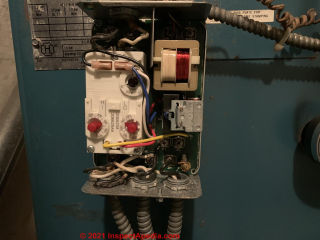 Omnid
Omnid
Please see AQUASTAT LO & DIFF DISABLED
and let me know if that leaves you with further questions
On 2021-01-14 by Ommid
Our home had a domestic water heating which is now shut and we use electric hot water. The oil burner still connected to the old hot water system. When I bring down the temperature on thermostats boiler runs to keep the minimum temperature for DHW.
That causes unnecessary cycle of heating the boiler even if rooms do not need heating.
I do not know what to do to tell the boiler not to heat the water when rooms do not require heating. One option can be to set the low temperature to minimum. But it will still cycle between min and max all the time.
Any advise would be much appreciated.
On 2020-10-14 by (mod) - wiring a new Honeywell Aquastat on an old Arcoliner oil fired boiler
Nick that ought to be pretty straight-forward: the same power connections and thermostat connections will be found in just about any new boiler aquastat control you might obtain; the specifics of exactly where those terminals are found in the individual new aquastat will vary, but they're clearly labeled and even better, are described in the installation instructions specific to and packaged with the aquastat.
If you've got a new aquastat but lost the installation instructions for it, you will find wiring instructions both in the article above and in PDF downloads for individual aquastat models cited here and in the recommended-reading articles listed at the end of the article above.
Then if specific questions or problems arise don't hesitate to ask us about it.
By the way
In your photo I see an opening into your oil fired boilers flue-vent connector elbow close to the heater - where someone has removed an older stack relay control. That opening should be closed.
I also see what looks like corroded copper piping and leaks above the TACO circulator pump that are worth a look.
And I assume those dangling wires are just temporary; don't leave any 120VAC electrical splices outside of electrical boxes.
On 2020-10-14 by Nick
Im looking for info on wiring a new Honeywell oil control to my old arcoliner furnace with the arcoflame oil burner
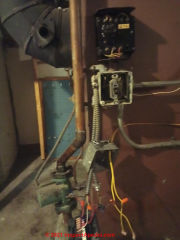
On 2020-10-14 by (mod) - how do I wire up a replacement aquastat?
 Nick that ought to be pretty straight-forward: the same power connections and thermostat connections will be found in just about any new boiler aquastat control you might obtain; the specifics of exactly where those terminals are found in the individual new aquastat will vary, but they're clearly labeled and even better, are described in the installation instructions specific to and packaged with the aquastat.
Nick that ought to be pretty straight-forward: the same power connections and thermostat connections will be found in just about any new boiler aquastat control you might obtain; the specifics of exactly where those terminals are found in the individual new aquastat will vary, but they're clearly labeled and even better, are described in the installation instructions specific to and packaged with the aquastat.
If you've got a new aquastat but lost the installation instructions for it, you will find wiring instructions both in the article above and in PDF downloads for individual aquastat models cited here and in the recommended-reading articles listed at the end of the article above.
Then if specific questions or problems arise don't hesitate to ask us about it.
By the way
In your photo I see an opening into your oil fired boilers flue-vent connector elbow close to the heater - where someone has removed an older stack relay control. That opening should be closed.
I also see what looks like corroded copper piping and leaks above the TACO circulator pump that are worth a look.
And I assume those dangling wires are just temporary; don't leave any 120VAC electrical splices outside of electrical boxes.
On 2020-10-14 by Nick
Im looking for info on wiring a new Honeywell oil control to my old arcoliner furnace with the arcoflame oil burner [Photo above]
On 2020-09-25 by mod)
Tom
Let's start with the diagnostics at CIRCULATOR PUMP WON'T START https://inspectapedia.com/heat/Circulator_Pump_No_Start_Repair.php
On 2020-09-25 by tom
t-stats work boiler or circulation pump do not
On 2019-10-11 by (mod)
The first thing I would have tried which is the simplest and no cost is to set the low limit and differential to give you the most hot water in the offseason.
As long as you keep the low 20 below a high on the control you can push them both up such that the high is near 200 and the low just under-180
On 2019-09-18 by Chris
Hi there. Question on wiring gauge and proper hookup. We have a beckett oil burner/furnace/hot water maker. It has a honeywell R7284U Oil Primary, a Honeywell L8124AC aquastat, a power vent, and a Field Controls WMO-1 200 flue blocked vent switch. My question is with regards to the wiring requirements needed to go from the R7284U to the WMO-1.
The WMO-1 was put in in place of some other blocked flue detector (I don't recall what it was) and they reused the wiring. The way in which they hooked it up was with the preexisting 22 or 24 gauge wire. The WMO-1 wires were up to the LIMIT wire and the NEUTRAL (I believe this is L2) wire where they entered the R7284U mounting box.
My understanding is that the WMO-1 should be in between B1 of the aquastat and the LIMIT port on the R7284U. Is this correct?
An additional question, is 22 or 24 gauge thick enough wire?
I'm not sure how much current is flowing from B1 to the LIMIT connection, but I would thing that 22 gauge is not enough for a 120VAC. If I'm reading the manual correctly this limit can carry upwards of 7 AMPS.
Thanks
Chris
On 2019-01-29 (mod)
Tankkess
See
AQUASTAT HI LO DIFF SETTINGS
https://inspectapedia.com/heat/Aquastat_Settings.php
On 2019-01-29 by Tankless water heater temp adjustment
How do you adjust the tankless water heater temperature for domestic hot water usage on this agustat on the oil burner boiler furnace
On 2018-12-23 by (mod)
George,
Try the aquastat setting suggestions at
AQUASTAT HI LO DIFF SETTINGS
https://inspectapedia.com/heat/Aquastat_Settings.php
On 2018-12-22 by george
how to wire aquastat into relay transformer system with circulator
I have a Weil / McLain boiler with 2 zones using a what appears to be a 8182D Aquastat controller. I rewired things so that the thermostats control only the circulator on each zone respectively. Since doing so the boiler seems to keep the temp at the low setting (140F) only and does not ever reach the hi setting of 180F. What changes do I need to make so that the burner fires at 140 and turns off at 180?
...
Continue reading at MANUALS for HEATING SYSTEM CONTROLS aquastat installation & repair guides, or select a topic from the closely-related articles below, or see the complete ARTICLE INDEX.
Or see AQUASTAT CONTROL FAQs - questions and answers about boiler control aquastats posted originally on this page.
Or see these
Recommended Articles
- AQUASTAT CONTROLS - home
- AQUASTAT HI LO DIFF SETTINGS
- AQUASTAT LO & DIFF DISABLED
- AQUASTAT L4006, L4006E, L4007 HONEYWELL GUIDE [PDF]
- AQUASTAT L4080B,D & L8080A HONEYWELL MANUAL [PDF]
- AQUASTAT L4080B,D,F,G & L8080A HONEYWELL MANUAL [PDF]
- AQUASTAT L6006A HONEYWELL GUIDE
- AQUASTAT L7224U UNIVERSAL OPERATION & ERROR CODES
- AQUASTAT L7224U UNIVERSAL DIAGNOSIS
- AQUASTAT L8124 AQUASTAT INSTALL / REPAIR
- AQUASTAT L8148 AQUASTAT INSTALLATION
- AQUASTAT L8148 HONEYWELL DIAGNOSIS & REPAIR
- AQUASTAT R8182-SERIES CONTROL
- AQUASTAT RESET BUTTON
- AQUASTAT SENSOR PROBE HEAT CONDUCTING COMPOUND
- AQUASTAT SENSOR PROBE STUCK in the AQUASTAT WELL
- AQUASTAT SETTINGS vs HEATING COST
- AQUASTAT SELECTION GUIDE
- OUTDOOR RESET MODULE AQUASTAT ADJUSTER
- REMOTE THERMOSTAT CONTROLS for HVAC
- TANKLESS COIL HOT WATER HEATER TEMPERATURE CONTROL
- MANUALS & PARTS GUIDES - HVAC - home
- MANUALS for HEATING & A/C SYSTEM CONTROLS - home
- SINGLE FUNCTION LIMIT SWITCH
- WATER HEATER TEMPERATURE ADJUSTMENT CONTROLS
Suggested citation for this web page
AQUASTAT CONTROLS at InspectApedia.com - online encyclopedia of building & environmental inspection, testing, diagnosis, repair, & problem prevention advice.
Or see this
INDEX to RELATED ARTICLES: ARTICLE INDEX to HEATING BOILERS
Or use the SEARCH BOX found below to Ask a Question or Search InspectApedia
Ask a Question or Search InspectApedia
Try the search box just below, or if you prefer, post a question or comment in the Comments box below and we will respond promptly.
Search the InspectApedia website
Note: appearance of your Comment below may be delayed: if your comment contains an image, photograph, web link, or text that looks to the software as if it might be a web link, your posting will appear after it has been approved by a moderator. Apologies for the delay.
Only one image can be added per comment but you can post as many comments, and therefore images, as you like.
You will not receive a notification when a response to your question has been posted.
Please bookmark this page to make it easy for you to check back for our response.
Our Comment Box is provided by Countable Web Productions countable.ca
Citations & References
In addition to any citations in the article above, a full list is available on request.
- Thanks to Bottini Fuel service manager Ron Thomas for discussing aquastat functions, low limit controls, oil burner short cycling causes, and boiler maintenance, reliability, and service contracts 4/13/2010. Bottini Fuel is a residential and commercial heating oil distributor and oil heat service company in Wappingers Falls, NY and with offices in other New York locations. Bottini Fuel, 2785 W Main St, Wappingers Falls NY, 12590-1576 (845) 297-5580 more contact information for Bottini Fuel
- Thanks to reader powderfinger5 for careful reading of this text and suggesting clarifications - August 2011
- Thanks to reader Gary (Buddy Cat) for careful reading & editing - November 2012
We provide links just below to several aquastat installation, setting, and adjustment documents in response to reader requests and comments that people sometimes have difficulty finding this information. But readers looking for specific aquastat control information should always first try the control manufacturer.
- Armstrong 24-hour time and aquastat control accessory: provides on/off pump control according to preset operating times, designed only for use with specified Armstrong Astro series wet roto circulators installed in indoor hot water re circulation applications. Typical timer applications will cycle the pump at preset times, allowing the user to select operation of the circulating pump during high peak usage periods in order to decrease the delivery time to outlet fixtures and reduce wasted water, also available at www.honeywell.com
- Honeywell Corporation, control installation guides for Honeywell aquastats and other heating and cooling controls: see http://customer.honeywell.com
- Honeywell L4008E Aquastat high limit,manual reset, aquastat controller instructions
- Honeywell L4041A,C Pool Heater Aquastat Controller Instructions, also available at www.honeywell.com
- Honeywell L4006, Manual Reset Strap-On Aquastat (high limit control, 100 to 240 °F) [we consider strap on controls less accurate and reliable than immersion type sensor controls; these were commonly found on older heating boilers including the GE series downfired boilers]
- Honeywell L4026B Aquastat control instructions (contact Honeywell Corporation) Here is some basic description of the Honeywell L4026B control, also available at www.honeywell.com
- Honeywell L4029 Reset Limit Control, also available at www.honeywell.com
- Honeywell L4103A,B,C Combination Aquastat and High Limit Controller Instructions, also available at www.honeywell.com
- Honeywell L6006A Aquastat Controller installation instructions, also available at www.honeywell.com
- Honeywell L6006 and L6007 Aquastat Controllers, installation instructions for the trained service technician, these controls combine low or high limit and circulator control, with or without an immersion well depending on the control model A,B, C etc., also available at www.honeywell.com
- Honeywell L6191 Dual aquastat immersion thermostat, also available at www.honeywell.com
- Honeywell R7184 Interrupted Electronic Oil Primary R7184A,B,P,U Installation Instructions, also available at www.honeywell.com
- Honeywell R7184 Series Primary Controls Technicians Quick Reference Guide, also available at www.honeywell.com
- Honeywell L7224 Aquastat Controller, oil electronic controls allowing high limit, high limit differential, low limit, and separate low limit differential settings - set to the specifications of your oil heating equipment manufacturer - 69-1957-1 L7224 Series controls, also available at www.honeywell.com
- Honeywell L7224U Oil Electronic Aquastat Controller - 69-1720-2 series instructions. These newer aquastat controllers are often used to replace the older Honeywell L8124A series that was and remains widely used, also available at www.honeywell.com.
- L7224U1002- is a universal electronic aquastat (replacing over 40 other aquastat models) that provides circulator, burner and boiler temperature control with electronic temperature sensing. The L7224U1002 provides status and diagnostic information through an LED display to enhance the diagnostic process.
In "Run" mode the LED displays the boiler temperature followed by the ambient temperature. Buttons inside the control permit the service tech to scan through the control's settings as well as to change them, much like the functions on a programmable room thermostat. Using the "I" button, the LED display can be cycled through: boiler temperature, high limit, low limit, high differential, low differential, local thermostat status, EnviraCOM thermostat status, Burner status, Circulator status, Zone control, Zone request, Error code, °F/degC.
Five diagnostic LEDs inside the control provide additional diagnostic features, indicating (counterclockwise from upper left) EnviraCOM network active, Thermostat calling for heat, Burner on, Power to zone circulator interrupted (lockout), Circulator powered.
This is a "triple aquastat" providing High, Low, and circulator controls, as well as advanced features permitting electronic configuration and an LED display for diagnostics. This aquastat can provide multiple zone control as well. The L7224U1002 supports Honeywell's EnviraCOM™ communications that permits remote diagnosis as well as OnWatch diagnostics. The low-limit can be disabled for "cold-start" boiler applications such as where no tankless coil is in use. - Eight error codes: 1=sensor fault (check sensor), 2=ECOM fault, check EnviraCOM wiring, 3=Hardware fault, replace the control, 4=B1 fault, check B1 wiring/voltage, 5=Low line voltage, check L1/L2 110VAC, 6=Fuse, check ECOM wires, replace fuse, 7=EEPROM limit and differential settings, restore to desired settings, 8=Repeated B1 fault, (voltage present at B1 when output is turned off); check B1 wiring/voltage
- Honeywell link for a powerpoint training session on this aquastat: http://customer.honeywell.com/NR/rdonlyres/5C67D10A-631C-4404-9149-25BA61F5D8BB/4041/L7224UUNIVERSALAQUASTATTrainingModule.ppt
- See L7224U1002 Technicians Quick Reference Guide #69-1957
- L7224U1002- is a universal electronic aquastat (replacing over 40 other aquastat models) that provides circulator, burner and boiler temperature control with electronic temperature sensing. The L7224U1002 provides status and diagnostic information through an LED display to enhance the diagnostic process.
- Honeywell L8124A,B,C,E,G,LO,M Aquastat Relays immersion type controllers for forced hydronic heating systems that include domestic hot water service (such as a tankless coil), also available at www.honeywell.com
- Honeywell R8182D,H Combination Protectorelay™ Primary Control and Aquastat® Controller Installation Instructions combination protectorelay Primary Control installation and operations manual, also available at www.honeywell.com
- Domestic and Commercial Oil Burners, Charles H. Burkhardt, McGraw Hill Book Company, New York 3rd Ed 1969.
- "Residential Hydronic (circulating hot water) Heating Systems", Instructional Technologies Institute, Inc., 145 "D" Grassy Plain St., Bethel, CT 06801 800/227-1663 [home inspection training material] 1987
- Heating, Ventilating, and Air Conditioning Volume I, Heating Fundamentals,
- Boilers, Boiler Conversions, James E. Brumbaugh, ISBN 0-672-23389-4 (v. 1) Volume II, Oil, Gas, and Coal Burners, Controls, Ducts, Piping, Valves, James E. Brumbaugh, ISBN 0-672-23390-7 (v. 2) Volume III, Radiant Heating, Water Heaters, Ventilation, Air Conditioning, Heat Pumps, Air Cleaners, James E. Brumbaugh, ISBN 0-672-23383-5 (v. 3) or ISBN 0-672-23380-0 (set) Special Sales Director, Macmillan Publishing Co., 866 Third Ave., New York, NY 10022. Macmillan Publishing Co., NY
- In addition to citations & references found in this article, see the research citations given at the end of the related articles found at our suggested
CONTINUE READING or RECOMMENDED ARTICLES.
- Carson, Dunlop & Associates Ltd., 120 Carlton Street Suite 407, Toronto ON M5A 4K2. Tel: (416) 964-9415 1-800-268-7070 Email: info@carsondunlop.com. Alan Carson is a past president of ASHI, the American Society of Home Inspectors.
Thanks to Alan Carson and Bob Dunlop, for permission for InspectAPedia to use text excerpts from The HOME REFERENCE BOOK - the Encyclopedia of Homes and to use illustrations from The ILLUSTRATED HOME .
Carson Dunlop Associates provides extensive home inspection education and report writing material. In gratitude we provide links to tsome Carson Dunlop Associates products and services.


